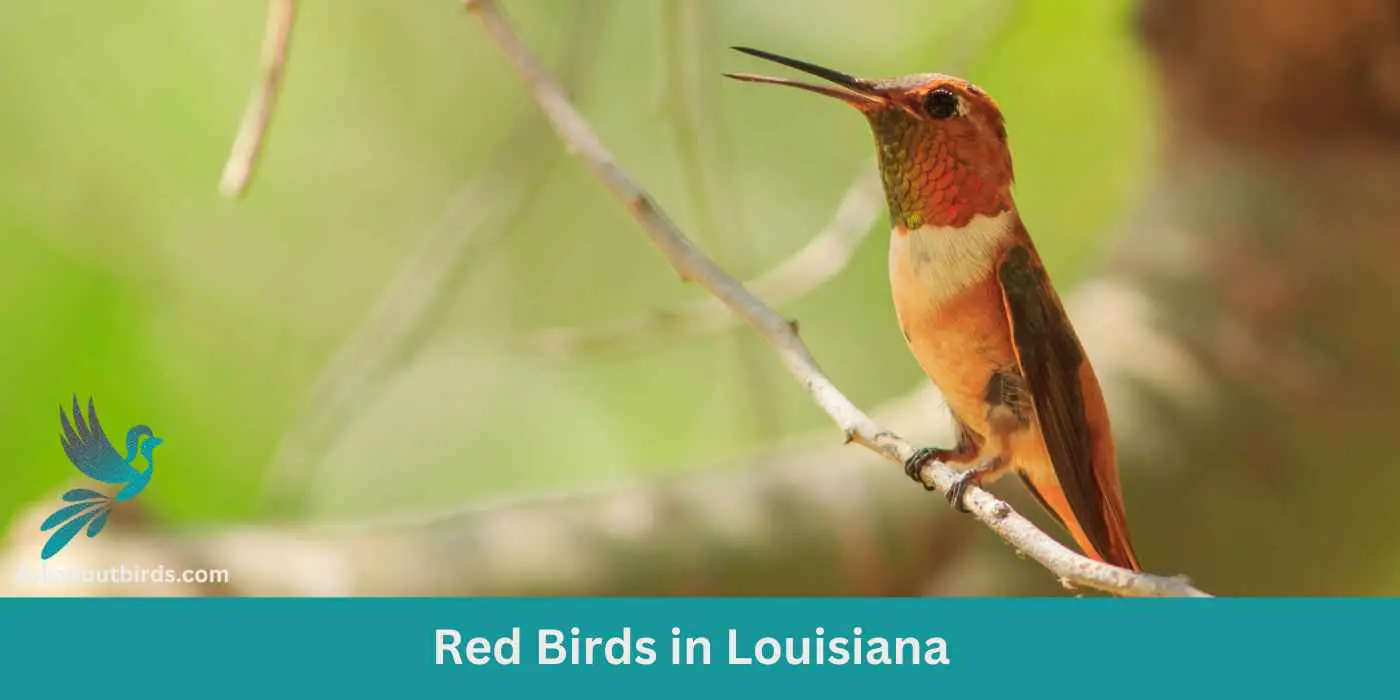Louisiana, often hailed as the ‘Jewel of the South,’ is not just renowned for its rich culture and history, but also for its breathtaking biodiversity. Among the state’s myriad of wildlife are the radiant red birds that soar through its skies and perch on its trees.
Dive into the captivating world of these crimson-hued avians with our guide, detailing 12 of the most striking red birds found in Louisiana.
Red Birds Found In Louisiana
With its rich tapestry of habitats ranging from coastal marshes to hardwood forests, Louisiana serves as a sanctuary for a multitude of bird species. The state’s waterways and marshlands provide abundant food resources and nesting grounds, especially for waterfowl and wading birds.
Northern Cardinal


| Feature | Measurement |
|---|---|
| Scientific Name | Cardinalis cardinalis |
| Length | 8.3 – 9.1 in |
| Wingspan | 9.8 – 12.2 in |
| Weight | 1.19 – 2.29 oz |
The Northern Cardinal is an iconic North American bird, easily recognized by its vibrant color and melodious song.
Appearance: Male Northern Cardinals are a brilliant scarlet red, while females display a more subdued reddish olive. Both sexes have a distinctive black ‘mask’ on their face around the bill and a pointed crest on their head. The bird’s beak is robust, cone-shaped, and bright orange in color.
Diet: Northern Cardinals are primarily granivorous, with a diet largely consisting of seeds and grains. They also eat fruits and insects. These birds typically feed off the ground and are frequent visitors to bird feeders.
Reproduction: Northern Cardinals are monogamous, and a pair will breed together for life. The female typically builds a well-hidden nest in a dense thicket or shrub. She lays 2-5 eggs per clutch, which she incubates for around two weeks.
Summer Tanager


| Feature | Measurement |
|---|---|
| Scientific Name | Piranga rubra |
| Length | 6.7 in |
| Wingspan | 28 to 30 cm |
| Weight | 29 g |
The Summer Tanager is a medium-sized songbird admired for its radiant plumage and melodious song.
Appearance: Male Summer Tanagers are an impressive bright red, while females and juveniles present a softer, yellow-orange color. Both genders have a large, slightly hooked bill and relatively short tail.
Diet: Summer Tanagers primarily feed on insects, including bees and wasps, which they catch in flight or pick off vegetation. They are also known to eat fruits and berries, making them helpful in controlling pest populations and seed dispersal.
Reproduction: The female Summer Tanager builds a loose, shallow cup-shaped nest out of twigs and grass, usually hidden in the foliage of trees. The female typically lays 3-5 eggs, which she will incubate for about two weeks.
Scarlet Tanager


| Feature | Measurement |
|---|---|
| Scientific Name | Piranga olivacea |
| Length | 6.3 to 7.5 in |
| Wingspan | 9.8 to 11.8 in |
| Weight | 23.5 to 38 g |
The Scarlet Tanager is a strikingly colorful bird known for its brilliant plumage and distinctive song.
Appearance: Male Scarlet Tanagers are notable for their vibrant scarlet bodies contrasted with black wings and tail, making them one of the most intensely colored birds. Females and juveniles, on the other hand, have a subdued olive-yellow body color with darker wings and tail.
Diet: The diet of the Scarlet Tanager is largely made up of insects, including beetles, cicadas, aphids, and others. They are adept flycatchers, seizing insects in mid-air or picking them off foliage. They also consume fruits and berries, especially during migration and in their winter habitats.
Reproduction: The female Scarlet Tanager builds a cup-shaped nest using twigs, rootlets, and grass, typically well-hidden in the dense foliage of trees. She lays 3 to 5 eggs and incubates them for about two weeks.
Red-headed Woodpecker

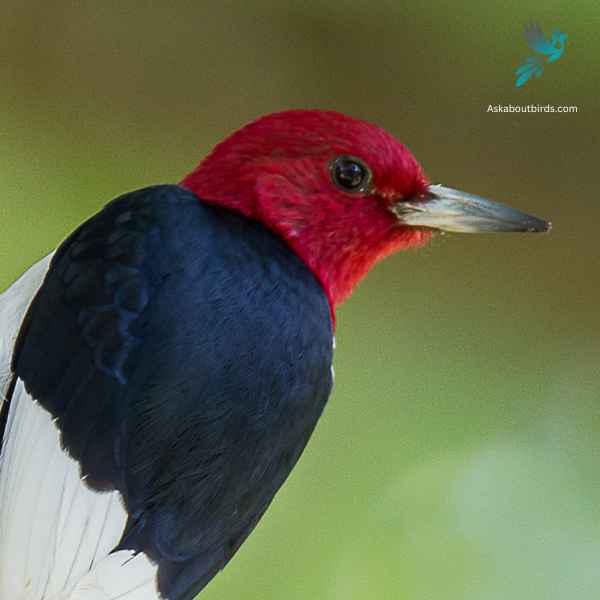
| Feature | Measurement |
|---|---|
| Scientific Name | Melanerpes erythrocephalus |
| Length | 7.5–9.1 in |
| Wingspan | 16.5 in |
| Weight | 2.0–3.2 oz |
The Red-headed Woodpecker is a striking forest bird with a bold tri-colored pattern.
Appearance: This woodpecker features a completely red head and neck, contrasting starkly with its white underparts and black wings. Its wings also have large white patches which are conspicuous in flight.
Diet: Red-headed Woodpeckers have a varied diet including insects, seeds, fruits, berries, and occasionally even the eggs of other birds. They’re also known to store food by wedging it into crevices in bark.
Reproduction: These woodpeckers nest in cavities which they excavate in dead wood or dead parts of live trees. These cavities can be found anywhere from 2 to 80 feet off the ground.
Red-bellied Woodpecker
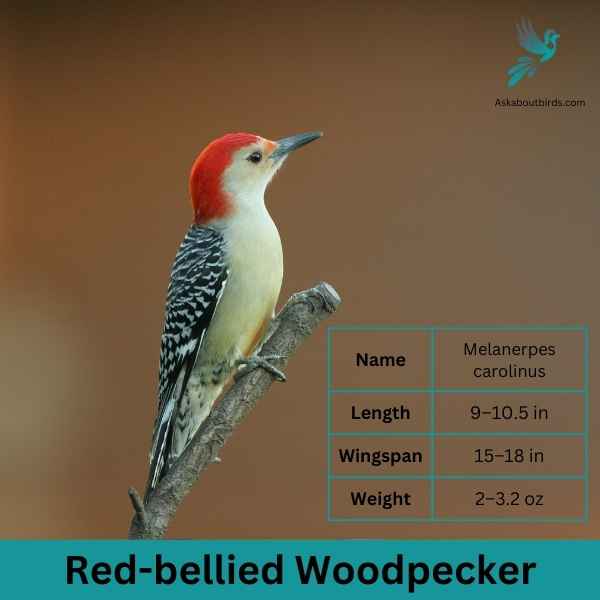
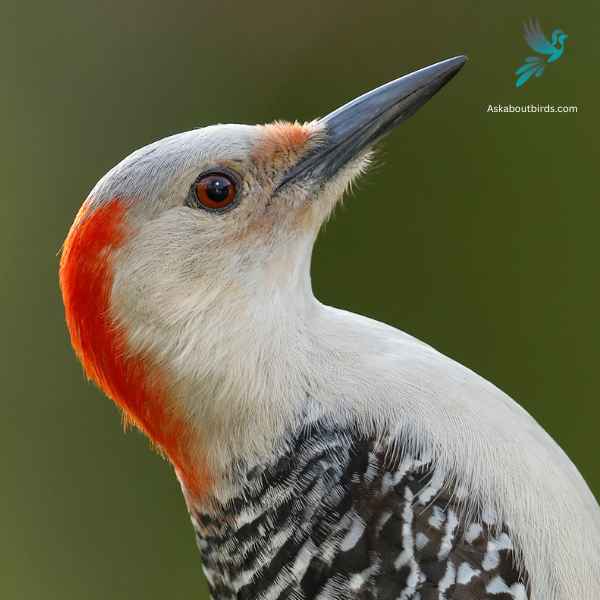
| Feature | Measurement |
|---|---|
| Scientific Name | Thryothorus ludovicianus |
| Length | 4.7–5.5 in |
| Wingspan | 11 in |
| Weight | 0.63–0.81 oz |
The Red-bellied Woodpecker is a medium-sized woodpecker commonly found in woodlands, forests, and backyards across the eastern and central U.S.
Appearance: The Red-bellied Woodpecker sports a pale gray face, throat, and belly, contrasted by a zebra-striped back. Its name derives from the subtle reddish tinge on its belly, but it’s more commonly recognized by the vivid red cap on the head of males and the partial red cap on females.
Diet: This woodpecker has a varied diet that includes insects, fruits, nuts, and seeds. They frequently forage on tree trunks and branches, using their sticky, barbed-tipped tongue to extract ants, beetles, and other insects from crevices.
Reproduction: Red-bellied Woodpeckers are cavity nesters, excavating holes in tree trunks for their nests. The inside of the nest is typically unlined or sparingly lined with wood chips.
Vermilion Flycatcher
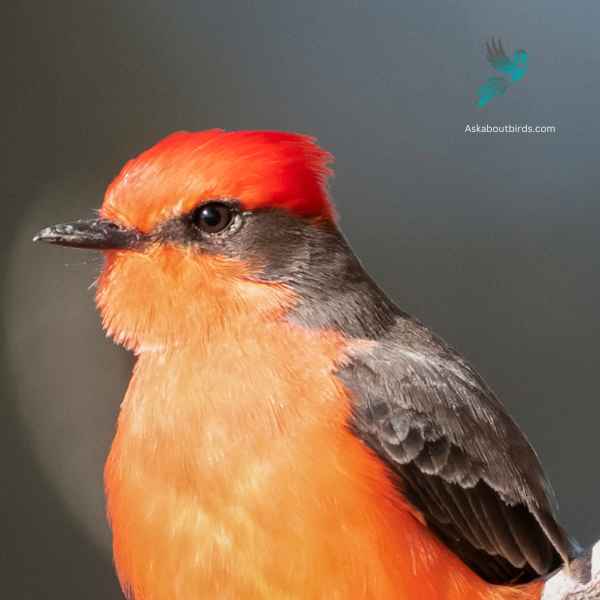

| Feature | Measurement |
|---|---|
| Scientific Name | Pyrocephalus obscurus |
| Length | 5.1–5.5 in |
| Wingspan | 9.4 to 9.8 in |
| Weight | 11 to 14 g |
The Vermilion Flycatcher is a small and colorful bird native to the Americas. The male Vermilion Flycatcher is a striking sight, displaying a vibrant red plumage on its head, breast, and underparts, contrasting with its brown wings and black tail below. Females, on the other hand, have more muted colors, featuring a pale yellowish belly and grayish-brown upperparts.
Vermilion Flycatchers are known for their lively and acrobatic flight displays, which they perform during courtship or to defend their territories. They often sing a series of soft, whistled notes while engaged in these aerial displays. They construct cup-shaped nests, usually in shrubs or low trees, where females lay their eggs and raise their young.
Red-Winged Blackbird
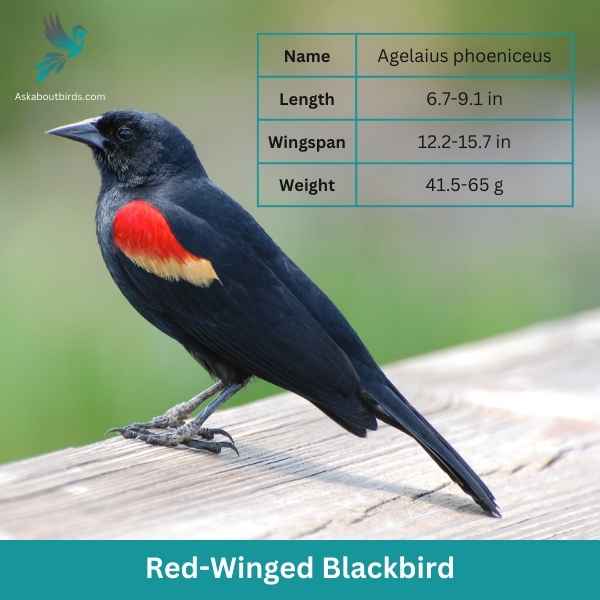
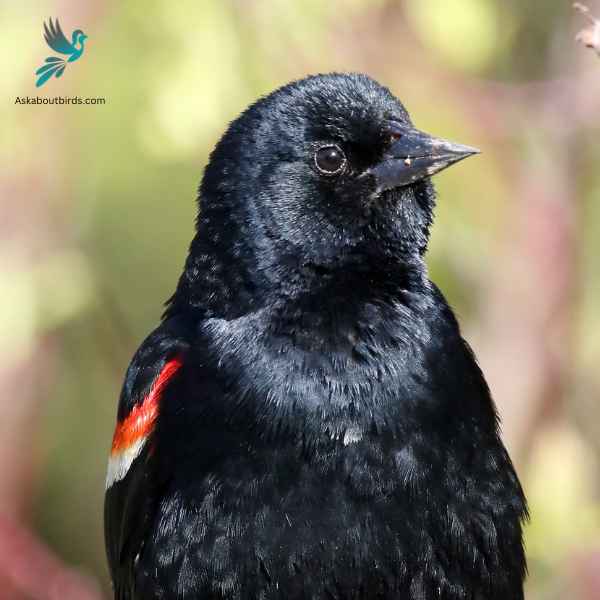
| Feature | Measurement |
|---|---|
| Scientific Name | Agelaius phoeniceus |
| Length | 6.7-9.1 in |
| Wingspan | 12.2-15.7 in |
| Weight | 41.5-65 g |
The Red-Winged Blackbird is a familiar sight across North America, especially in wetlands and open areas. Known for its striking coloration and distinct call, it is often seen perched on cattails or utility lines.
Appearance: Male Red-Winged Blackbirds are glossy black with bright red-and-yellow shoulder patches, while females are streaky brown, resembling a large sparrow. The males’ red patches become more prominent when they’re displaying or agitated.
Diet: Red-Winged Blackbirds primarily feed on seeds and insects. Their diet includes grains, sunflower seeds, and corn, but they also eat beetles, caterpillars, and other small invertebrates, especially in the breeding season.
Reproduction: Red-Winged Blackbirds nest in marshes, along watercourses, and in wet fields. The female constructs a cup-shaped nest using grass and sedge, attaching it to plants above water. She typically lays a clutch of 3 to 4 blue-green eggs, which she incubates for about 11-12 days. Males, being polygynous, often have multiple mates during a single breeding season.
Red Crossbill

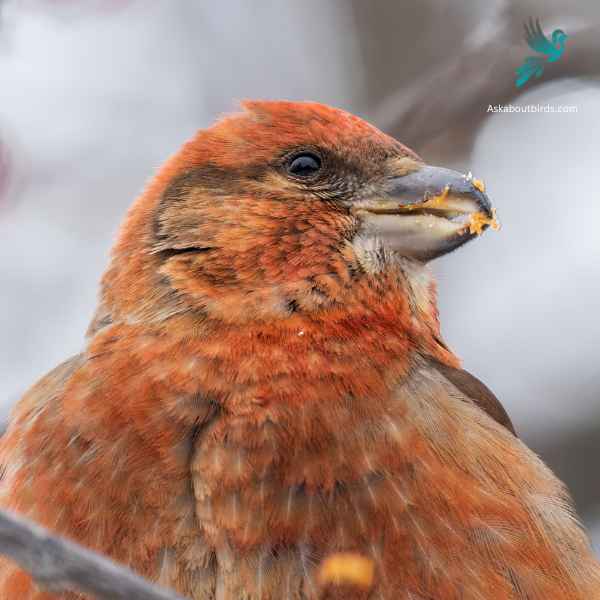
| Feature | Measurement |
|---|---|
| Scientific Name | Loxia curvirostra |
| Length | 5.5–7.5 in |
| Wingspan | 9.8–10.6 in |
| Weight | 0.9–1.4 oz |
The Red Crossbill is a distinctive finch known for its unusual bill, which has evolved to extract seeds from conifer cones.
Appearance: Males are typically bright red or orange, while females are greenish-yellow or olive. Both genders have the characteristic crossed bill, which they use to expertly extract seeds from tightly closed conifer cones.
Diet: Red Crossbills primarily feed on the seeds of coniferous trees, such as spruce, pine, and fir. Their specialized bills allow them to efficiently pry apart conifer cone scales to access the seeds.
Reproduction: Red Crossbills are somewhat nomadic and don’t adhere to a strict breeding schedule. Instead, they breed whenever and wherever food is abundant. Their nests are usually built on horizontal branches of conifer trees.
House Finch


| Feature | Measurement |
|---|---|
| Scientific Name | Haemorhous mexicanus |
| Length | 5–6 in |
| Wingspan | 8–10 in |
| Weight | 0.6–0.9 oz |
The House Finch is a small songbird widely distributed across North America and is commonly found in urban and suburban areas.
Appearance: Males of this species are brightly colored with crimson faces and throats, which can extend to the chest and back, while their flanks have streaks. The female is streaked brown and lacks the red coloring. Both have a square-tipped tail and a distinctively long, flat-topped bill.
Diet: House Finches primarily eat seeds, grains, and berries. They have a particular fondness for sunflower seeds and can be commonly seen at bird feeders. Occasionally, they will also consume insects, especially during the breeding season.
Reproduction: House Finches are cavity-nesters and might choose ledges, vents, ledges, and other urban settings. They might also utilize trees or shrubs. Their nests can be made of a wide array of materials, from feathers to twigs.
Pine Grosbeak

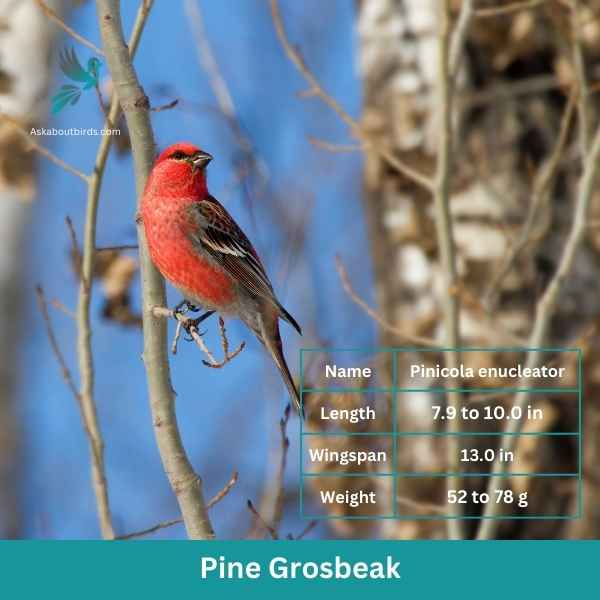
| Feature | Measurement |
|---|---|
| Scientific Name | Pinicola enucleator |
| Length | 7.9 to 10.0 in |
| Wingspan | 13.0 in |
| Weight | 52 to 78 g |
The Pine Grosbeak is a striking bird native to the northern regions of North America, often found in coniferous forests. Both males and females have a plump and robust body with a large beak adapted for eating seeds. The male Pine Grosbeak displays a vibrant reddish-pink plumage, while the female has a more subdued grayish-brown coloration.
These birds are typically seen in small flocks, foraging for food in trees and on the ground. They have a preference for seeds, particularly those from various conifer species. The Pine Grosbeak uses its strong bill to crack open the cones of tall trees and extract the seeds, but they also consume berries and small fruits when available.
Red-Breasted Merganser


| Feature | Measurement |
|---|---|
| Scientific Name | Mergus serrator |
| Length | 20–25 in |
| Wingspan | 26–29 in |
| Weight | 800–1,350 g |
The Red-breasted Merganser (Mergus serrator) is a species of sea duck known for its distinctive appearance and behavior. The bird boasts a slender, saw-toothed bill, a reddish-brown breast, and a fan-shaped, shaggy crest. In males, the head is strikingly green-black, the neck is white, and the back is black and white patterned. Females have a rusty brown head with a shaggy crest and a grayish body. Both sexes display the long, slender bill characteristic of mergansers, designed for catching and consuming fish.
Red-breasted Mergansers inhabit a wide range of environments, including freshwater lakes, rivers, coasts, and sometimes even open sea environments. The species is widely distributed across the Northern Hemisphere, breeding in the northern parts of North America and Eurasia, and wintering in milder climates. Their diet consists primarily of small fish, which they catch through rapid underwater dives. A unique behavior of Red-breasted Mergansers is their group hunting strategy, where they are often seen herding fish together to facilitate catching them. As of my knowledge cutoff in September 2021, the Red-breasted Merganser is listed as a species of “Least Concern” by the IUCN, indicating a stable global population. However, like all species, it could be impacted by future environmental changes and habitat loss.
Rufous Hummingbird


| Feature | Measurement |
|---|---|
| Scientific Name | Selasphorus rufus |
| Length | 3.1–3.9 in |
| Wingspan | 4.3 in |
| Weight | 0.1–0.2 oz |
The Rufous Hummingbird is a small, brilliantly colored bird known for its impressive migratory journeys and feisty behavior.
Appearance: The male Rufous Hummingbird boasts a gleaming orange-red body with a white chest and an iridescent red throat, called a gorget. The female has green upperparts with rufous-washed flanks and tail. Her throat may have some iridescent patches, but it’s generally whitish.
Diet: Like other hummingbirds, the Rufous Hummingbird primarily feeds on nectar from a variety of flowering plants. They also eat insects and spiders for protein, catching them in flight or plucking them from vegetation.
Reproduction: Rufous Hummingbirds nest in trees, shrubs, or even ferns. The female alone selects the site, builds the nest, and cares for the offspring.
Where to Spot Louisiana’s Red Birds
Louisiana’s diverse landscapes, from its iconic bayous to the expansive Mississippi delta, offer birdwatchers unparalleled opportunities to witness a wide array of avian life. Here are some top locations in the state renowned for their bird-watching potential:
- Atchafalaya Basin: The largest wetland and swamp in the U.S., this basin is a haven for waterfowl, wading birds, and numerous other species. The serene waterways provide exceptional opportunities for spotting red birds amidst cypress trees.
- Sabine National Wildlife Refuge: Located on the Gulf Coast, this refuge is a critical stopover for migratory birds. Its mix of marshes, wetlands, and prairies attracts a rich diversity of birdlife, making it a top spot for viewing red birds.
- Cameron Prairie National Wildlife Refuge: A mosaic of marshes, prairies, and ponds, this refuge is home to hundreds of bird species. The boardwalks and viewing platforms offer prime vantage points for birdwatching.
- Barataria Preserve (Jean Lafitte National Historical Park and Preserve): Just a stone’s throw from New Orleans, this preserve boasts bayous, swamps, and marshes, making it a prime location to see red birds and other vibrant Louisiana species.
- Kisatchie National Forest: This is Louisiana’s only national forest, offering a different habitat of piney hills and hardwood forests. The varied topography attracts a diverse set of birds, including many red-hued species.
| State’s Red birds | Top Birdwatching Spots |
|---|---|
| Texas’s Red birds | 1. High Island Reserves 2. South Padre Island 3. Big Bend National Park |
| Arkansas’s Red birds | 1. Hot Springs National Park 2. Delta Rivers Nature Center 3. Holla Bend National Wildlife Refuge |
| Mississippi’s Red birds | 1. Noxubee National Wildlife Refuge 2. Mississippi Sandhill Crane National Wildlife Refuge 3. St. Catherine Creek National Wildlife Refuge |
FAQs on Red Bird Species Found in Louisiana
What medium-sized bird with bright red plumage frequently visits backyard feeders in Louisiana?
The Purple Finch, specifically the males, stands out with its bright red plumage. In Louisiana, they are known to frequently visit backyard bird feeders, especially those filled with black oil sunflower seeds, making them a delight for bird enthusiasts in the region.
Are Painted Buntings, known for their vibrant colors, common visitors to Louisiana’s bird feeders?
Yes, Painted Buntings, particularly the males with their unique combination of green wings, yellow-green belly, and bright red plumage, are common visitors to backyard feeders in Louisiana. They are particularly attracted to sunflower seed feeders and platform feeders, offering bird watchers a spectacular view.
Which rare species with red feathers might be spotted occasionally in Louisiana?
The Hepatic Tanager, while primarily breeding in evergreen forests of the northern and western states, can occasionally be considered an “accidental or rare species” in Louisiana. These tanagers have a rosy pink head and red feathers, distinguishing them from the more common birds in the region.
Where can you typically find purple finches?
Purple finches, distinguishable from the more common house finch by their distinctive color and markings, are often observed in the forest canopy and forest edges across the eastern United States. During certain seasons, they are known to visit bird feeders, especially in backyards, making them a delightful sight for bird enthusiasts.

